Definition of A Planet
Kids Vote: Is Pluto A Planet In Our Solar System?
Our planet worksheet investigates the characteristics of a planet.
Free Download Below
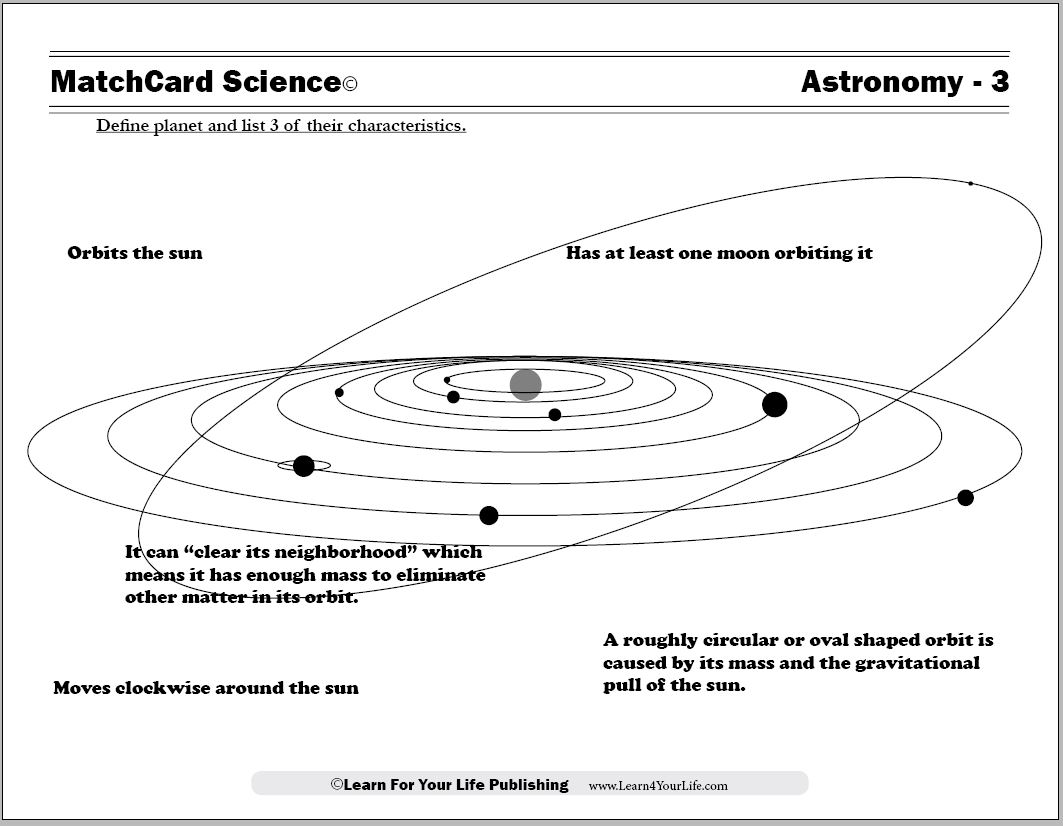
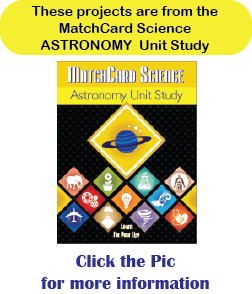
The Planet Definition Worksheet
Objective: List the three characteristics of planets. Investigate if Pluto is a planet or not.
MatchCard: Download below.
MatchCard Information Pieces identify the order of the planets and their size, orbit time, and distance from the sun.
Download and Use the Definition of a Planet MatchCard


Click image to go to download.
This is MatchCard #3 of the Astronomy Unit Study. Find more information on MatchCard Science below.
What Is A Planet
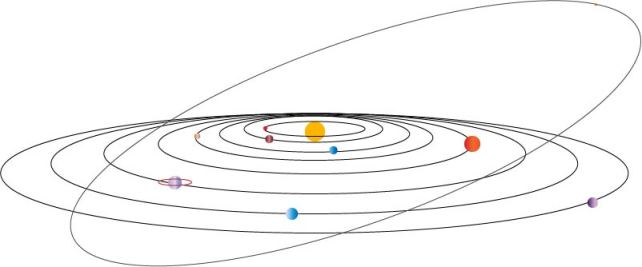
Definition Of A Planet: 3 Factors That Make A Planet
Official, Scientific Definition of A Planet
Here is the official definition of a planet according to the International Astronomical Union:“A planet is a celestial body that (a) is in orbit around the Sun, (b) has sufficient mass for its self-gravity to overcome rigid body forces so that it assumes a hydrostatic equilibrium (nearly round) shape, and (c) has cleared the neighbourhood around its orbit.”
1: Planets Orbit Around the Sun
This is an easy concept. Students investigated the revolution of the Earth around in the sun in the rotation vs. revolution lesson. All planets (as well as other bodies) rotate around the sun.Semantics: Solar System
Think of the origin of the name "solar system." How is it related to this definition of a planet?
2: A Planet's Orbit is Spherical
The orbit of a planet is spherical (or round.) None of the planets have perfectly round orbits, they are more eliptical or oval shaped.If you haven't done so in art class, you might want to practice drawing elipses now. Start by drawing a circle in the center for the sun. Then draw the elipses around the sun to show the planets' orbits.
Newton, Gravity, and The Definition of Planets
Students learn about 3 effects of gravity in the Force & Motion MatchCard #5.Isaac Newton was sitting under the famed apple tree at his mother's farm contemplating why the moon orbits the sun instead of going in a straight line which explains, in addition to other things, why he never became a farmer. Most people take it for granted that the moon goes around the sun, but he figured that plain common sense would make a moving object go straight. What force made it curve? In the middle of his contemplations an apple fell from the tree (legend says it bonked him in the head, but he never said that.) Ah ha! He surmised that the same force that causes the great attraction between the apple and the center of the earth also causes an attraction between the moon and the earth leading to the discovery of gravity.
Later a few historicans, who sometimes have an annoying habit of thinking they know more about what happened in the past than the people who lived in that era, disputed that an apple actually fell from the tree. Good grief, there doesn't seem to be any possible ulterior motive for Newton to lie about such a common event. But nonetheless the current legend is that the legend of the apple didn't happen.
The lesson here is that gravity's exertion on the moon (or a planet) pulls it in a circular path around a body with larger mass. It also explains the spherical shape of that orbit.
3: Clear the Neighborhood
The third characteristic of planets (and the one that got Pluto kicked out of the hood) is that a planet has enough mass to clear it's neighborhood.What that means is that the planet is big enough that it either obliterates any other matter in its orbit, or collects that matter into it's own body, or turns the matter into a moon that orbits itself.
The orbit of our Earth, for instance, has no large objects in its orbit other than itself and its moon. Good thing, too. Yes, an occasional meteor or comet may cross it's path, but then get obliterated.
Is Pluto A Planet?
History of Pluto
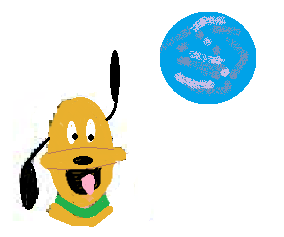 When I was a kid, we had nine planets in our solar system. At least I was told we had nine planets and it never occured to me or anyone else I knew to question that fact.
When I was a kid, we had nine planets in our solar system. At least I was told we had nine planets and it never occured to me or anyone else I knew to question that fact.The early astronomers of ancient times were aware of the planets and named many of them after gods (Jupiter, Mars, Venus, etc.) After the telescope was invented in the 16th century, more planets were discovered and named. It was not until 1930, however, that the last and furthermost planet was found and named Pluto. Hence, your mother probably learned the mneumonic, "My Very Eager Mother Just Served Us Nine Pizzas" instead of "Nachos."
Then in 2006 the International Astronomical Union voted to demote Pluto when they agreed on a definition of a planet. Pluto met the first two characteristics, but it did not meet the third characteristic of clearing its neighborhood. More powerful telescopes have sighted a fair amount of matter out there in Pluto's orbit. It was demoted from a planet to a "dwarf planet" of which there are many.
It was a bit disorienting to find that Mickey Mouse's pet dog was no longer a planet. However, Pluto was not named for the Disney character but for the Greek god of the underworld - which ignores the question of who came up with the idea of a mouse having a pet dog.
Anyway it took a bit of adjusting for humanoids to accept that one of their favorite planets wasn't a planet, but somehow they managed to go about their usual lives. Then in October of 2014 the earthlings got another jolt when it was announced that some astronomers, including the chairman of the Planet Definition Committee of the International Astronomical Union think Pluto really IS a planet. "Pluto is back," shouted the headlines. Actually, Pluto never left. But the IAU is still THE official body of astronomers, and since they have not officially changed their definition, Pluto is still listed as a dwarf-planet.
Discussion Questions
- Who do you think should get to decide if something is a planet or not?
- Does the vote of a scientific organization change scientific "facts."
- What was happening in the world in 1930 when Pluto was discovered? Do you think the announcement had much impact?
- After doing the activities below, you can decide if you think Pluto should be on the list or not.
A Closer Look At Pluto

Planet Size
Look at the size of all the planets. The small four small planets are close to the sun, the larger planets are further away. Does Pluto fit with this arrangement?Let's Watch A Flyover of Pluto
We may not be able to take a trip but we can view the surface in this NASA New Horizons flyover video of Pluto which is only 2 minutes long. You might want to particularly view the mountains at the 30 to 45 second mark.Pluto's Moons
In Astronomy MatchCard #2 Planets in the Solar System students made a chart comparing planets' size and the number of moons. Add Pluto to the list with 3 moons. Hmmm, once again, you see Pluto is a little different. Tiny little Pluto does not fit the hypothesis that the larger the size of a planet, the greater the number of moons it has. Pluto is about 1/5 the size of Earth, but has 3x more moons. Hey, that's not fair!Pluto's three moons are Charon, Nix, and Hydra. But there is something strange going on here.
Charon is about half the size of Pluto. They are so close together that they were considered one planet before the powerful, modern telescopes were invented. Their orbit is different too. They orbit around each other. Try it yourself with two people. In one case have one person orbit around the other. Then have both holding both hands and orbiting around a point in the center between them. Hmmm, that's not how most moons and planets act, is it?
What About Pluto's Orbit?
We learned about the Earth's Revolution and Rotation in the last Astronomy MatchCard. The planets revolve around the sun as they orbit.Pluto's orbit is a little bit different. Can you tell the two differences? (Answer: The sun is not in the center, and it orbits on a different plane than the eight others.)
Explain The Plane
Here is an activity to explain the geometric concept of planes to students who are not familiar with it.Put three objects (like pennys) on a table top and explain they are on the same plane. Hold a fourth penny above the table and show it is not on the same plane.
Any 2 Points: A Line
By definition, any two points can be on a line. Use the pennies and a pencil to show this. Have them put the pennies anywhere on the table. Move the pencil to show that there can be a line between any two points (they need to imagine the ends of the pencil extending out indefinitely as a line does.)
Any 3 Points: A Plane
Now take a sheet of paper and explain it represents a plane. Move the paper into several locations to show planes are formed at different angles.
Now have the student put the pencil any where on the table and the third penny above it. Show how the paper can be tilted to incorporate the points on the pencil line, and be tilted to incorporate any third point in space. (Again, if they make the third point too far away, you need to imagine the line from the pencil extending in the same direction.)
Look at the picture on the MatchCard and see how the orbit of Pluto is on a different plane.
Pluto's Neighborhood
Kuiper Belt
When the astronomers debated if Pluto was a planet, there was one definition of planet that Pluto could not pass. A planet must be large enough and have enough mass that it "clears its neighborhood."What does that mean?
In the case of Earth, and the other 7 closer planets, they are big large objects with nothing in their orbits but themselves and their moons. Every once in a while an asteroid or something comes bumbling into the orbit and either gets consumed or sent out of the neighborhood.
However, there is lots of stuff in Pluto's neighborhood, and Pluto is only one tiny fraction of the mass hanging out way out there in the far reaches of our solar system. In fact, other spheres called dwarf planets are out there in what is now known as the Kuiper Belt. One is even larger than Pluto.
This brings up another point: Maybe the other planets closer to the sun have been able to clear the neighborhood because of their sheer size and weight. They either break up other objects or make them join their cohort as a moon. Maybe all the other planets should be considered big bullies.
What Is A Plutoid?
While Plutonians may feel snubbed that their favorite planet was declassified, they may take some encouragement that a new set of solar bodies are named after Pluto. The International Astronomy Union (IAU) which is the same orginazation that defined Pluto as a "dwarf planet" gives us this 2008 definition of plutoids are on their website:Plutoids are celestial bodies in orbit around the Sun at a distance greater than Neptune that are sufficiently large to form a nearly spherical shape and that have not cleared the neighbourhood around their orbit. Satellites of plutoids are not plutoids themselves, even if they are massive enough to be nearly round. The two known and named plutoids are Pluto and Eris. We expect that more plutoids will be named as science progresses and new discoveries are made.
Eris, it turns out, is even bigger than Pluto, by 30% and also lives in the Kuiper Belt. In fact, there may be many other dwarf planets lurking out there in the outer reaches of our solar system.Your Time to Vote
Okay, now you get to vote. Would you keep Pluto as a planet?- Yes, Pluto is a planet.
- Nope, Pluto is only a dwarf planet.
If you do vote to keep nine planets, there are actually organizations you can belong to to campaign on behalf of beloved Pluto.
Uh oh, one more thing. If you chose to keep Pluto as a planet, would you chose to list some of the other objects in the Kuiper Belt that are currently listed as dwarf planets as regular planets?
Hmmm, your very eager mother may be serving you a lot more than just pizzas and nachos.
MatchCard Science
How To Use MatchCards
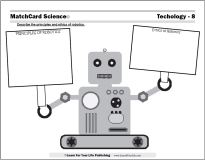
Download the FREE MatchCard Science Instructor's Guide and see how MatchCards can make building their science knowledge base fun.
Astronomy Unit Study
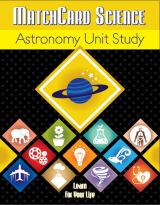
Explore the universe with the MatchCard Science Astronomy Unit Study..
12 Science Unit Studies

Chemistry is only one of twelve complete unit studies for kids in 3rd to 8th grade.
Comprehensive objectives, hands-on projects, suggested science fair experiments, and the fun game-like MatchCards keep them interested in learning science. See all twelve MatchCard Science Unit Studies.
About Our Site
Hands-On Learning













